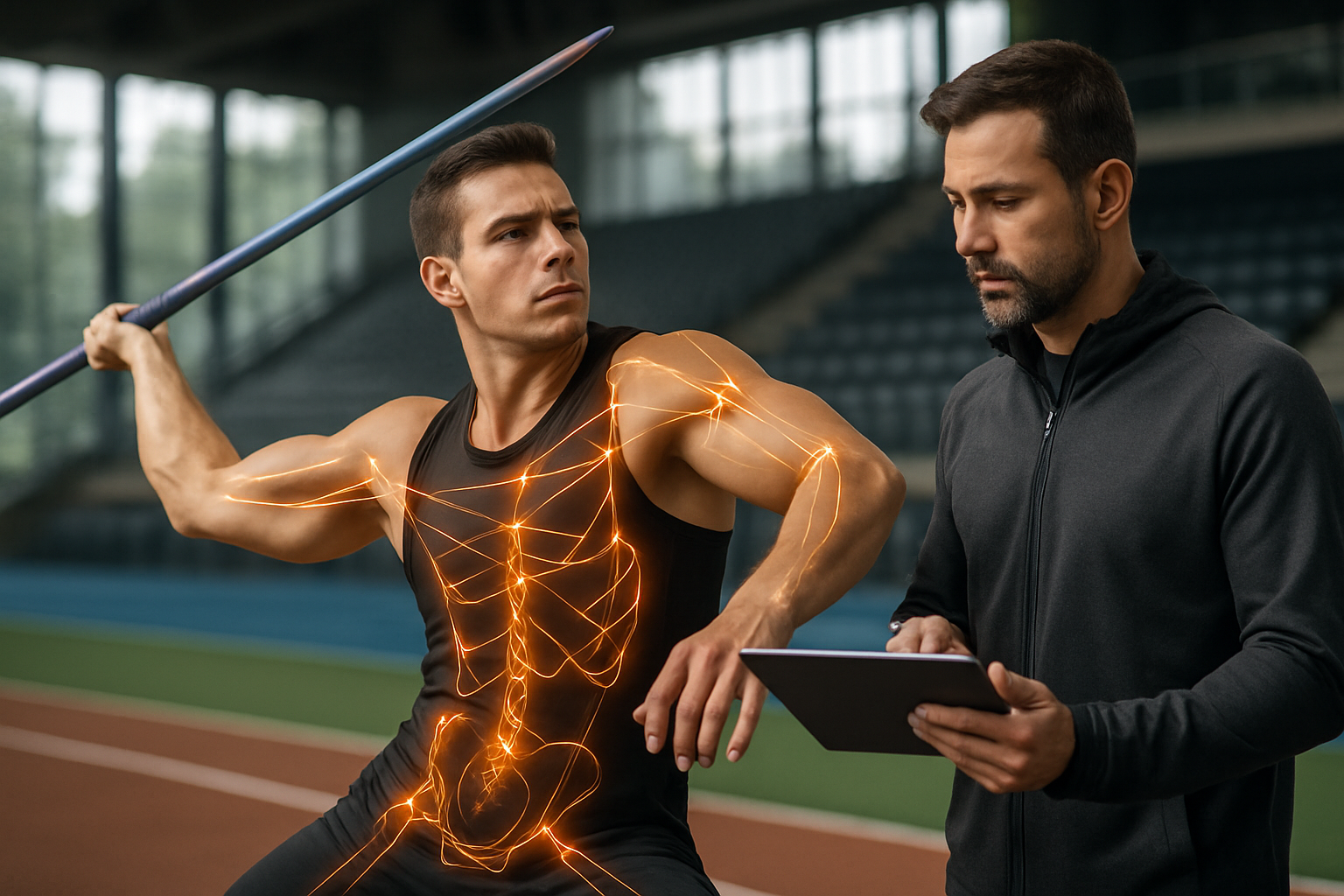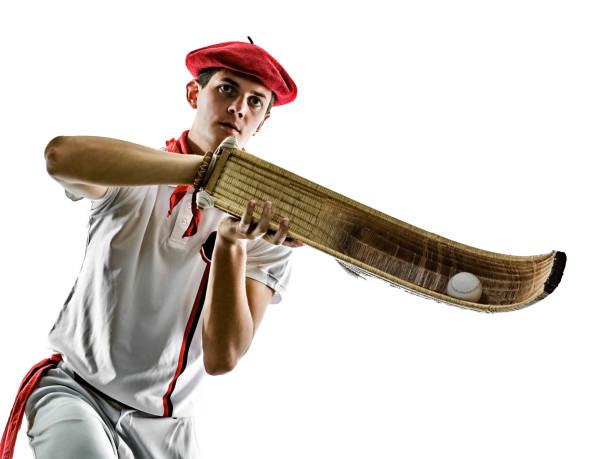Biomechanics of Javelin Throwing: Unlocking Peak Performance
The whistle of a javelin cutting through the air, followed by the satisfying thud as it pierces the ground, marks the culmination of years of training and precise execution. Javelin throwing, an Olympic event with roots in ancient warfare, has evolved into a fascinating intersection of raw power, technique, and aerodynamics. This article delves into the intricate biomechanics behind this captivating sport, exploring how athletes push the boundaries of human performance through a deep understanding of physics and physiology.

Today’s javelin throwers are not just athletes; they’re living, breathing projectile launchers. The modern javelin throw is a complex dance of kinetic energy transfer, from the ground through the thrower’s body and into the implement. This process involves a delicate balance of strength, flexibility, and precise timing.
The evolution of javelin design has been equally fascinating. Early javelins were simple wooden spears, but today’s competition javelins are precisely engineered tools. Made from materials like aluminum or carbon fiber, modern javelins are designed to maximize flight characteristics while conforming to strict regulations set by World Athletics.
The Runway: Building Momentum
The biomechanics of javelin throwing begin long before the athlete releases the implement. The approach, or runway phase, is crucial in generating the initial momentum that will ultimately propel the javelin. This phase typically involves a run-up of about 30 meters, during which the thrower accelerates to an optimal speed.
During this approach, the athlete’s body acts as a system for storing potential energy. The rhythmic pattern of the run-up allows for the coordinated recruitment of muscle groups, particularly in the lower body. Studies have shown that elite javelin throwers can reach speeds of up to 7 meters per second during their approach, translating to significant kinetic energy.
The final few steps of the approach are particularly critical. Athletes often employ a crossover technique, where they transition from a forward-facing run to a sideways movement. This shift allows for the rotation of the hips and torso, setting up the body for the throwing action. The crossover steps also facilitate the lengthening of the throwing arm, creating what biomechanists call the “tension arc” – a loaded position from which explosive power can be generated.
The Throw: A Symphony of Motion
The actual throwing motion in javelin is a complex sequence of movements that occurs in a fraction of a second. It begins with the plant foot hitting the ground, initiating what’s known as the “block” phase. This sudden deceleration of the lower body creates a whip-like effect, transferring energy up through the kinetic chain.
As the plant foot stabilizes, the thrower’s hips begin to rotate forward, followed by the torso. This sequential rotation is crucial for maximizing the power of the throw. Biomechanical analyses have shown that up to 70% of the javelin’s velocity at release comes from this rotational movement, rather than from the arm action alone.
The throwing arm follows a path often described as an “overhead whip.” Starting from an extended position behind the body, it rapidly accelerates forward, with the elbow leading the way. Just before release, the elbow extends explosively, transferring the accumulated energy into the javelin.
At the moment of release, elite throwers can generate angular velocities of up to 2000 degrees per second at the shoulder joint. This incredible speed, combined with precise timing and positioning, determines the javelin’s initial trajectory and spin – crucial factors in achieving maximum distance.
Aerodynamics: The Javelin’s Flight
Once released, the javelin’s journey through the air is governed by the laws of aerodynamics. The implement’s design plays a crucial role here, with its tapered shape and carefully positioned center of gravity optimizing its flight characteristics.
During flight, the javelin experiences several forces: gravity pulling it downward, air resistance slowing its forward motion, and lift forces acting perpendicular to its trajectory. The javelin’s spin, imparted by the thrower’s release technique, helps stabilize its flight by creating a gyroscopic effect.
One of the most intriguing aspects of javelin aerodynamics is the phenomenon known as “attack angle.” This refers to the angle between the javelin’s long axis and its trajectory through the air. Research has shown that an optimal attack angle of around 5-10 degrees can significantly increase the distance of the throw by generating additional lift.
The javelin’s flight path is not a simple parabola, as one might expect. Instead, it follows a complex curve influenced by changing aerodynamic forces as its speed and angle change throughout the flight. Understanding and optimizing this flight path is a key area of focus for both athletes and coaches.
Biomechanical Optimization: Technique and Training
Improving javelin throwing performance requires a deep understanding of the biomechanics involved. Coaches and athletes use a variety of tools and techniques to analyze and refine the throwing motion.
High-speed video analysis allows for frame-by-frame examination of the throw, helping to identify areas for improvement in technique. Motion capture technology, similar to that used in the film industry, provides even more detailed data on joint angles, velocities, and accelerations throughout the throwing motion.
Force plate analysis during the plant and throw phases gives insight into the ground reaction forces involved, helping athletes optimize their power transfer from the ground up. Electromyography (EMG) studies reveal the precise timing and intensity of muscle activations, guiding strength and conditioning programs.
Training for javelin throwing involves a holistic approach to athletic development. Strength training focuses on developing power in the legs, core, and upper body. Plyometric exercises enhance the ability to generate explosive force. Flexibility work, particularly in the shoulder and trunk, is crucial for achieving the extreme ranges of motion required for an effective throw.
Technique drills often break down the throwing motion into component parts, allowing athletes to focus on specific aspects of the movement. For example, “medicine ball javelin throws” help develop rotational power, while “standing throws” isolate the upper body mechanics.
Injury Prevention and Performance Longevity
The extreme forces involved in javelin throwing put significant stress on the athlete’s body, particularly the shoulder and elbow joints. Understanding the biomechanics of the throw is crucial not just for performance enhancement, but also for injury prevention.
Research has shown that poor throwing mechanics can lead to a variety of injuries, including rotator cuff tears, labral injuries, and ulnar collateral ligament damage. By optimizing technique to distribute forces more evenly throughout the kinetic chain, athletes can reduce their risk of injury and extend their competitive careers.
Biomechanical analysis helps identify potential risk factors in an individual’s throwing technique. For example, excessive horizontal adduction of the shoulder or a “dropped” elbow during the throw can increase stress on the joint structures. Correcting these issues through targeted technique work and strengthening exercises can significantly reduce injury risk.
Recovery and regeneration strategies are also informed by biomechanical understanding. Techniques like active release therapy, dry needling, and specialized stretching protocols target the specific muscle groups and connective tissues stressed during throwing.
The Future of Javelin Biomechanics
As technology advances, so too does our understanding of javelin throwing biomechanics. Emerging tools like wearable sensors and artificial intelligence-driven analysis promise to provide even more detailed insights into the throwing motion.
Virtual reality training environments are being developed that allow athletes to practice and refine their technique in a controlled, data-rich setting. These systems can provide real-time feedback on factors like release angle, velocity, and body positioning, allowing for rapid technique adjustments.
3D printing technology is opening up new possibilities in javelin design and customization. While competition javelins must conform to strict regulations, training implements can be tailored to an individual athlete’s biomechanics, potentially accelerating skill development.
Genetic research is also beginning to play a role in understanding individual variations in throwing ability. Studies are exploring how certain genetic markers might predispose athletes to excel in power-based throwing events, potentially influencing talent identification and training strategies.
The Human Element: Psychology and Biomechanics
While biomechanics provides a scientific framework for understanding javelin throwing, the psychological aspects of the sport cannot be overlooked. The ability to execute a perfect throw under the pressure of competition requires not just physical skill, but also mental fortitude.
Research in sports psychology has shown that visualization techniques can enhance motor learning and performance. By mentally rehearsing the throwing motion, athletes can reinforce neural pathways and improve their execution. Some studies suggest that combining physical practice with mental imagery can lead to greater improvements than physical practice alone.
The concept of “flow state” – a mental condition of full immersion and focus – is particularly relevant to javelin throwing. Achieving this state of mind can allow athletes to execute their technique more fluidly and effectively. Understanding the biomechanics of the throw can actually contribute to reaching this flow state, as it allows the athlete to trust in their body’s ability to perform the complex movement pattern.
Conclusion: The Ongoing Quest for the Perfect Throw
The biomechanics of javelin throwing represent a fascinating confluence of physics, physiology, and athletic skill. As our understanding of these complex interactions deepens, so too does the potential for human performance in this ancient yet ever-evolving sport.
From the initial run-up to the final release and flight of the javelin, every aspect of the throw is a testament to the remarkable capabilities of the human body. The ongoing research and technological advancements in this field continue to push the boundaries of what’s possible, inspiring athletes to reach for ever-greater distances.
As we look to the future of javelin throwing, it’s clear that the pursuit of the perfect throw will continue to captivate athletes, coaches, and scientists alike. This enduring quest not only drives progress in the sport itself but also contributes valuable insights to our broader understanding of human movement and performance.
The javelin’s flight – a brief moment that encapsulates years of training, centuries of tradition, and cutting-edge scientific knowledge – remains one of the most compelling spectacles in athletics. It stands as a powerful reminder of the extraordinary achievements possible when human determination meets scientific understanding.





